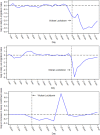Does city lockdown prevent the spread of COVID-19? New evidence from the synthetic control method
- PMID: 34193312
- PMCID: PMC8245276
- DOI: 10.1186/s41256-021-00204-4
Does city lockdown prevent the spread of COVID-19? New evidence from the synthetic control method
Abstract
Background: At 10 a.m. on January 23, 2020 Wuhan, China imposed a 76-day travel lockdown on its 11 million residents in order to stop the spread of COVID-19. This lockdown represented the largest quarantine in the history of public health and provides us with an opportunity to critically examine the relationship between a city lockdown on human mobility and controlling the spread of a viral epidemic, in this case COVID-19. This study aims to assess the causal impact of the Wuhan lockdown on population movement and the increase of newly confirmed COVID-19 cases.
Methods: Based on the daily panel data from 279 Chinese cities, our research is the first to apply the synthetic control approach to empirically analyze the causal relationship between the Wuhan lockdown of its population mobility and the progression of newly confirmed COVID-19 cases. By using a weighted average of available control cities to reproduce the counterfactual outcome trajectory that the treated city would have experienced in the absence of the lockdown, the synthetic control approach overcomes the sample selection bias and policy endogeneity problems that can arise from previous empirical methods in selecting control units.
Results: In our example, the lockdown of Wuhan reduced mobility inflow by approximately 60 % and outflow by about 50 %. A significant reduction of new cases was observed within four days of the lockdown. The increase in new cases declined by around 50% during this period. However, the suppression effect became less discernible after this initial period of time. A 2.25-fold surge was found for the increase in new cases on the fifth day following the lockdown, after which it died down rapidly.
Conclusions: Our study provided urgently needed and reliable causal evidence that city lockdown can be an effective short-term tool in containing and delaying the spread of a viral epidemic. Further, the city lockdown strategy can buy time during which countries can mobilize an effective response in order to better prepare. Therefore, in spite of initial widespread skepticism, lockdowns are likely to be added to the response toolkit used for any future pandemic outbreak.
Keywords: COVID-19; Growth rate of newly confirmed cases; Population migration; Synthetic control method.
Conflict of interest statement
No conflicts to declare.
Figures






Similar articles
-
A tale of lockdown policies on the transmission of COVID-19 within and between Chinese cities: A study based on heterogeneous treatment effect.Econ Hum Biol. 2024 Apr;53:101365. doi: 10.1016/j.ehb.2024.101365. Epub 2024 Feb 5. Econ Hum Biol. 2024. PMID: 38340650
-
Impact of Wuhan lockdown on the spread of COVID-19 in China: a study based on the data of population mobility.Zhejiang Da Xue Xue Bao Yi Xue Ban. 2021 Feb 25;50(1):61-67. doi: 10.3724/zdxbyxb-2021-0021. Zhejiang Da Xue Xue Bao Yi Xue Ban. 2021. PMID: 34117846 Free PMC article. English.
-
The impact of lockdown in Wuhan on residents confidence in controlling COVID-19 outbreak at the destination cities.Front Public Health. 2022 Aug 15;10:902455. doi: 10.3389/fpubh.2022.902455. eCollection 2022. Front Public Health. 2022. PMID: 36045730 Free PMC article.
-
Effect of national and local lockdowns on the control of COVID-19 pandemic: a rapid review.Epidemiol Prev. 2020 Sep-Dec;44(5-6 Suppl 2):60-68. doi: 10.19191/EP20.5-6.S2.104. Epidemiol Prev. 2020. PMID: 33412795 Review. English.
-
COVID-19 Control: Can Germany Learn From China?Int J Health Policy Manag. 2020 Oct 1;9(10):432-435. doi: 10.34172/ijhpm.2020.78. Int J Health Policy Manag. 2020. PMID: 32610735 Free PMC article. Review.
Cited by
-
Evaluating the effectiveness of lockdowns and restrictions during SARS-CoV-2 variant waves in the Canadian province of Nova Scotia.Front Public Health. 2023 Apr 27;11:1142602. doi: 10.3389/fpubh.2023.1142602. eCollection 2023. Front Public Health. 2023. PMID: 37181684 Free PMC article.
-
Inverted U-shaped relationship between education and family health: The urban-rural gap in Chinese dual society.Front Public Health. 2023 Jan 11;10:1071245. doi: 10.3389/fpubh.2022.1071245. eCollection 2022. Front Public Health. 2023. PMID: 36711367 Free PMC article.
-
Lockdowns, Community Mobility Patterns, and COVID-19: A Retrospective Analysis of Data from 16 Countries.Healthc Inform Res. 2022 Apr;28(2):160-169. doi: 10.4258/hir.2022.28.2.160. Epub 2022 Apr 30. Healthc Inform Res. 2022. PMID: 35576984 Free PMC article.
-
The next viral pandemic-where do we stand?Folia Microbiol (Praha). 2025 Jun;70(3):505-516. doi: 10.1007/s12223-025-01256-6. Epub 2025 Mar 28. Folia Microbiol (Praha). 2025. PMID: 40153131 Review.
-
Effectiveness of social distancing measures and lockdowns for reducing transmission of COVID-19 in non-healthcare, community-based settings.Philos Trans A Math Phys Eng Sci. 2023 Oct 9;381(2257):20230132. doi: 10.1098/rsta.2023.0132. Epub 2023 Aug 23. Philos Trans A Math Phys Eng Sci. 2023. PMID: 37611629 Free PMC article.
References
-
- Yang, X. Timing and Support Safeguards for Reopening an Economy During COVID-19. World Journal of Public Health. 2021a;6(2):31–9.
-
- Yang, X. COVID-19 Cannot Sustainably Improve Air Quality: Evidence from Reopening an Economy. Journal of Health and Environmental Research. 2021b;7(2):94–104.
-
- Center for Disease Control and Prevention. About Variants of the Virus that Causes COVID-19. 2 Apr 2021. Available from: https://www.cdc.gov/coronavirus/2019-ncov/transmission/variant.html. Accessed 10 May 2021.
MeSH terms
LinkOut - more resources
Full Text Sources
Medical

